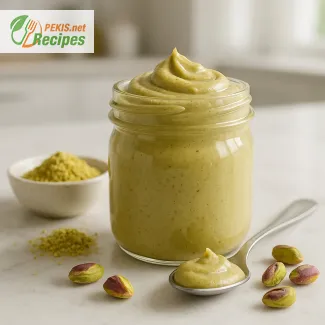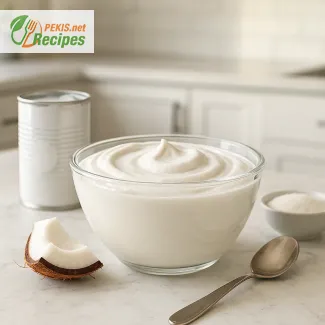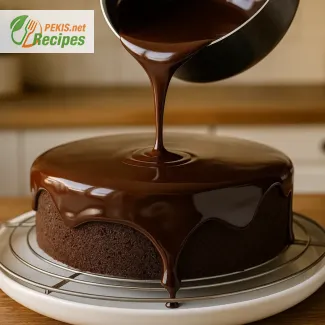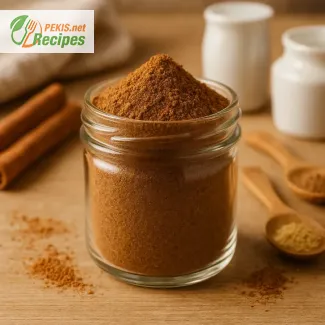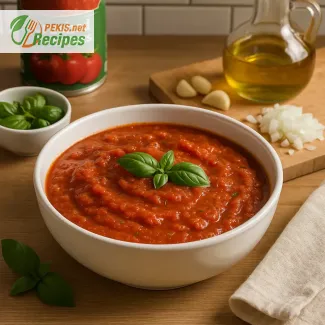A spoonful of fermented mild chili paste from fresh red peppers brings gentle warmth, smooth texture and a bright, tangy depth shaped by slow fermentation. Mild chilies, sweet peppers, garlic and salt transform into a creamy, spreadable paste that tastes like late-summer harvest preserved in a jar. Perfect for everyday cooking, marinades, bowls and quick flavour boosts.
Finding the perfect balance between gentle heat and bright fermented flavour always comes from respecting the natural sweetness of fresh red peppers and knowing how mild chilies behave during fermentation. A small tweak in salt level or jar space can completely change the depth of the paste, and that’s the kind of detail that makes this version so reliable for everyday cooking. PEKIS – professional chef and recipe developer with over 25 years of experience in cooking and baking, specialized in European and international cuisine.
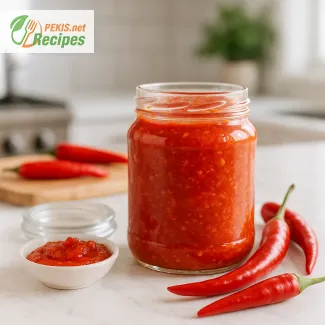
Small-batch fermented chili paste for everyday cooking comfort
Gentle heat, bright flavour and a creamy fermented chili spread you’ll reach for daily
When a spoonful of fermented mild chili paste melts into a warm pan, the aroma of fresh red peppers, garlic and a hint of lactic tang feels like standing in a cozy kitchen on a rainy evening. The texture is creamy, lightly spreadable, with tiny flecks of soft chili skin that cling to the spoon and coat vegetables, noodles or roasted meat in a thin, glowing red layer. Instead of a harsh, burning heat, every bite brings gentle warmth, balanced acidity and a subtle sweetness from slowly fermented peppers that have had time to develop depth and character.
This style of homemade chili paste is made for cooks who love flavour but do not want aggressive spiciness. Mild fresh chilies and sweet red peppers are blended with sea salt, a touch of garlic and sometimes onion or carrot to round out the taste. As the mixture ferments, natural bacteria transform simple ingredients into a complex, slightly tangy chili condiment that fits effortlessly into everyday meals: stirred into soups, whisked into dressings, brushed over grilled vegetables or spread thinly on a sandwich instead of mustard.
Fermented mild chili paste with fresh red peppers and garlic
At the heart of this paste are ripe red peppers and mild red chilies. Their natural sugars feed the fermentation, while sea salt keeps everything safe and crisp in flavour. Garlic adds a savoury backbone, giving the paste a umami-rich, almost roasted aroma once heated. A small amount of acidic brine or starter from another ferment can help kick-start the process, but the main work is done by wild lactic acid bacteria that thrive in a simple salty environment.
The result is a lacto-fermented chili paste that tastes brighter and cleaner than many cooked chili sauces. The heat is rounded, the acidity feels natural, and the salt is integrated instead of sharp. A small spoonful can replace both chili and vinegar in many recipes, making it a versatile base for marinades, stir-fries, grain bowls and even creamy dips.
Why you’ll love this recipe
- Gentle heat: delivers a mild chili warmth instead of overwhelming spiciness.
- Everyday versatility: works as a spread, marinade, stir-in sauce or base for dressings.
- Complex flavour: natural fermentation adds tang, depth and a subtle umami note.
- Small-batch friendly: easy to prepare in jars without special equipment.
- Better use of peppers: turns seasonal fresh red peppers into a long-lasting pantry staple.
For fans of fermented condiments, there is also a recipe for Homemade mild kimchi with extended fermentation for deeper flavour, which brings a similar balance of acidity, crunch and gentle chili warmth in a crunchy cabbage form.
Short origin story of fermented chili pastes
Fermenting chilies in salt has roots in many culinary traditions. In East Asia, fermented chili pastes evolved alongside soy and grain ferments, creating pantry staples that could season soups, stews and rice dishes all year. In parts of Europe and the Balkans, cooks preserved autumn peppers in barrels and jars, making mild chili spreads that lasted through winter and brightened heavy dishes.
This mild red pepper chili paste follows the same logic: take an abundant harvest of peppers, harness salt and time, and build a condiment that compresses the character of late summer into a single spoonful. The twist here is the focus on gentle heat, making it suitable for families, guests with lower spice tolerance and everyday cooking where balance matters more than intensity.
Storage and make-ahead tips for fermented mild chili paste
Because the paste is salted and fermented, it is naturally suited for make-ahead preparation and longer storage. Once fermentation has reached the desired tanginess, the jar is moved to a cooler environment to slow the process and keep the flavour stable.
- Refrigeration: stored in a clean, tightly closed jar, the paste can last for weeks or even months.
- Surface care: a thin layer of oil on top can help protect the surface from contact with air.
- Portioning: dividing into smaller jars reduces the number of times each jar is opened.
- Flavour development: the paste continues to evolve slowly, becoming rounder and deeper over time.
Preparing a larger batch in advance means a ready-to-use fermented chili base is always on hand, turning simple dishes like scrambled eggs, roasted potatoes or grilled cheese into something more layered and memorable.
Creative variations and serving ideas with fermented chili paste
Once the basic fermented mild chili paste is ready, small tweaks can adapt it to different cuisines and moods.
Creative variations
- Citrus twist: stir in a little lemon or lime zest after fermentation for a bright, fresh top note.
- Smoky version: add a pinch of smoked paprika or a small amount of smoked salt.
- Herb-infused: mix in finely chopped cilantro, parsley or oregano just before serving.
- Garlic-forward: increase the amount of garlic for a bolder, savoury spread.
Serving ideas
- Breakfast: swirl into scrambled eggs, spread under avocado toast or mix into yogurt for a savoury breakfast dip.
- Lunch and dinner: loosen with a bit of olive oil to brush over grilled vegetables, roasted chicken or fish.
- Bowls and salads: whisk with oil and a splash of citrus juice to form a quick warm salad dressing or grain bowl sauce.
- Snacks: serve as a dip with crusty bread, crackers or crisp raw vegetables for a light, flavourful appetizer.
Used in small amounts, this paste becomes a quiet backbone of flavour in the kitchen, adding heat, brightness and depth without overshadowing the ingredients around it.
- Rinse the fresh red peppers and mild chilies, remove stems and seeds, then cut into small pieces (1–2 cm / 0.4–0.8 inch).
- Place peppers, chilies and garlic in a blender and process until a smooth paste forms.
- Add sea salt and continue blending briefly to combine evenly.
- Transfer the paste to a clean jar, leaving at least 2 cm (0.8 inch) of headspace.
- Mix filtered water with apple cider vinegar and pour over the paste to lightly cover the surface.
- Close the jar loosely to allow gas release and let it ferment at room temperature for 72 hours.
- Stir the paste once per day using a clean spoon.
- After fermentation, tighten the lid and store the jar in the refrigerator.
- The paste will continue to develop deeper flavour over the following days.
FAQ questionHow spicy is fermented mild chili paste from fresh red peppers?
The heat level is gentle and manageable, because the paste is built on mild red chilies and sweet red peppers rather than very hot varieties. Fermentation also rounds off sharp edges of heat, leaving a warm, gradual burn instead of an immediate sting. Most people can enjoy a small spoonful straight from the jar on bread, eggs or vegetables without discomfort, while still getting a clear chili kick and bright, tangy flavour.
FAQ questionHow long does fermented mild chili paste last in the fridge?
Properly prepared and stored in a clean, tightly sealed jar, the paste can last several weeks to a few months in the refrigerator. The natural lactic acid from fermentation and the salt content help preserve it. Always use a clean spoon, press the paste down so it is compact, and if desired, cover the surface with a thin layer of neutral oil to reduce contact with air. If it develops an off smell, strange colour or visible mould, it should be discarded.
FAQ questionWhat can fermented mild chili paste be used for in everyday cooking?
This paste works as a multi-purpose flavour base. It can be stirred into soups, stews, sauces and grain bowls, spread thinly on sandwiches or wraps, whisked with oil and citrus for a quick salad dressing, or blended with yogurt or mayonnaise for a creamy dip. A teaspoon in a pan at the start of cooking creates a layered, aromatic foundation, replacing both fresh chili and part of the acidity you’d normally add with vinegar or lemon juice.
FAQ questionCan fermented mild chili paste be made less salty or less sour?
Salt and acidity are essential for safe fermentation and balanced flavour, but the overall impression can be adjusted. To make it feel less salty, use the paste in small amounts and pair it with unsalted ingredients like plain rice, potatoes or eggs, letting it season the whole dish. To soften the tangy taste, combine the paste with fat (olive oil, butter, yogurt) or natural sweetness from roast vegetables or honey in a dressing. Reducing salt too much in the ferment itself is not recommended, because it can affect both texture and safety.
FAQ questionWhat is the difference between fermented mild chili paste and regular chili sauce?
Regular chili sauce is usually cooked and often includes added sugar, vinegar and stabilizers, while fermented mild chili paste relies on raw peppers, salt and time. The flavour of this paste is brighter, more complex and naturally tangy, with a soft, creamy texture that spreads easily. Instead of a one-note burn, you get layers of gentle heat, sweetness and acidity that integrate into dishes rather than sitting on top of them. It also continues to evolve slowly in the fridge, gaining deeper savoury notes over time.
FAQ questionCan children or people sensitive to spice enjoy this mild fermented chili paste?
For many families, this paste becomes a bridge to spicy food, because it offers mild warmth instead of intense heat. A very small amount can be mixed into yogurt, mayonnaise or cream-based sauces to soften the kick even further. People who are highly sensitive to chili should still start with tiny quantities, but the focus on mild peppers and the balancing effect of fermentation makes it more approachable than most hot sauces.
Bringing together fresh red peppers, mild chilies and slow fermentation creates a paste that delivers both comfort and depth. The flavour opens with gentle warmth, then settles into a clean, tangy richness that works across everyday meals. It becomes one of those condiments that naturally finds a place beside the stove, ready to shape quick lunches, simple dinners or last-minute marinades.
The transformation that happens during fermentation gives the paste its unmistakable character. Natural bacteria develop a rounded acidity, softening the edges of heat and enhancing the natural sweetness of the peppers. The result is a balance that feels vibrant rather than sharp, making the paste suitable for a wide range of palates, including those who prefer mild spice.
Consistency is another part of its appeal. The texture stays smooth, creamy and easy to spread, holding enough body to cling to hot food without overpowering it. Whether stirred into a sauce or added as a finishing touch, it melts quickly and pulls the dish together with a subtle glow of flavour.
Over time, the jar becomes a quiet flavour booster: a spoonful in a pan, a swipe under roasted vegetables, a pinch blended into dressings. Its ability to adapt across cuisines and cooking methods is what makes it so valuable in a home kitchen. With just a few basic ingredients and the patience to let fermentation do its work, the paste becomes a reliable source of warmth, brightness and depth whenever a dish needs it.
Allergens present in the recipe
- None
- Gluten: none
How to remove allergens and gluten
- No allergens are present; no substitutions are required.
- Vitamin C (mg): 39 – contributes to immune function
- Vitamin A (µg): 155 – supports vision and skin health
- Potassium (mg): 175 – aids fluid balance and nerve function
- Calcium (mg): 7 – supports bone maintenance
- Iron (mg): 0.3 – contributes to normal oxygen transport
- Capsanthin (mg): 3.4 – supports cellular protection
- Beta-carotene (mg): 0.7 – acts as a precursor to vitamin A
- Flavonoids (mg): 5 – contribute to oxidative stress reduction
